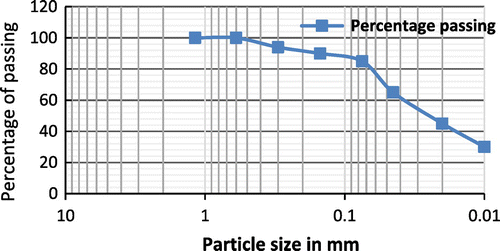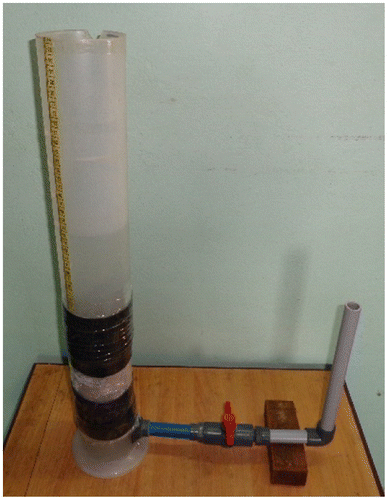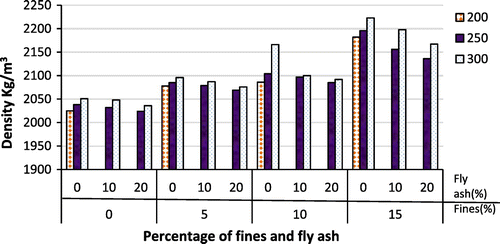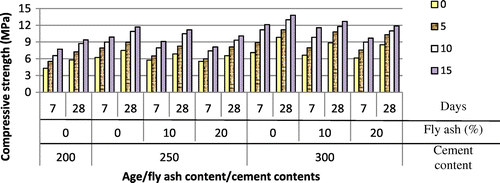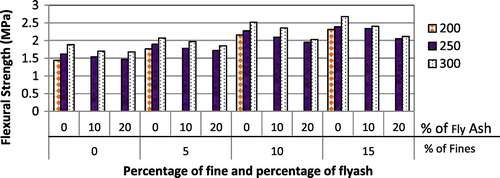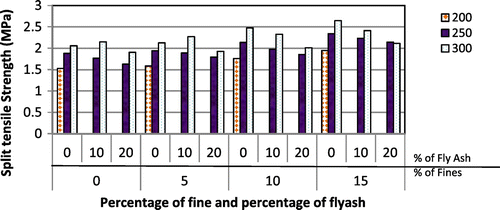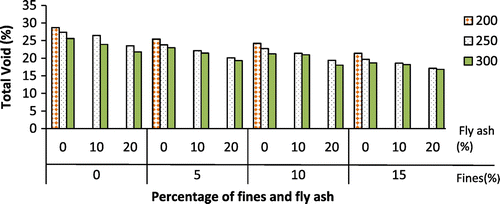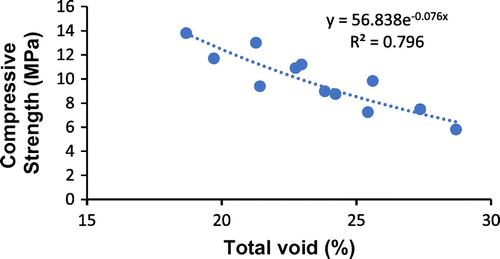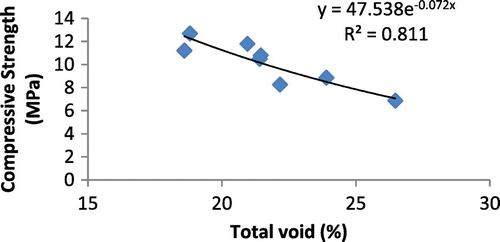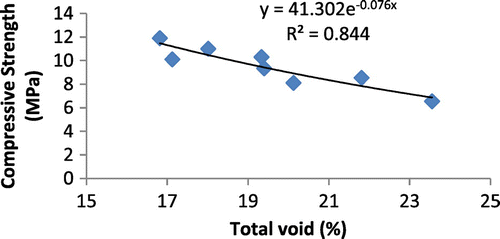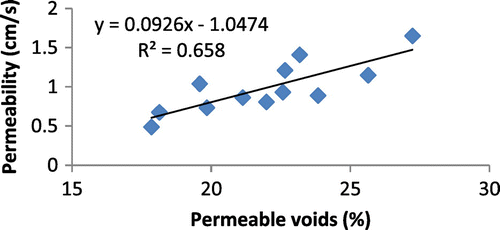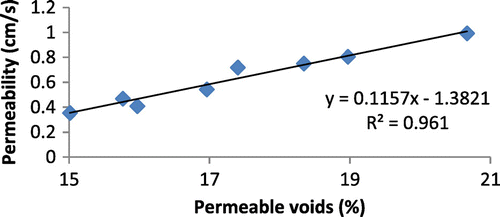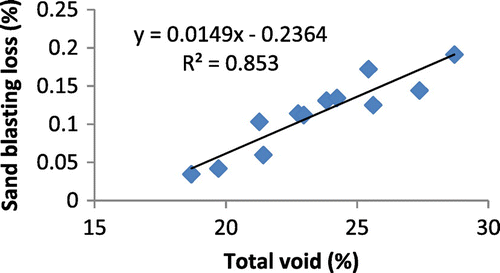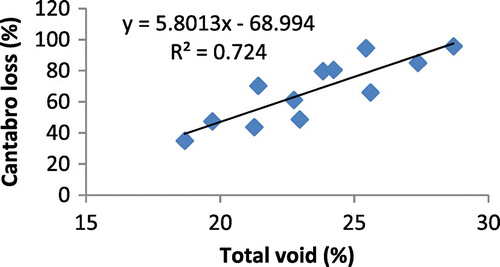 ?Mathematical formulae have been encoded as MathML and are displayed in this HTML version using MathJax in order to improve their display. Uncheck the box to turn MathJax off. This feature requires Javascript. Click on a formula to zoom.
?Mathematical formulae have been encoded as MathML and are displayed in this HTML version using MathJax in order to improve their display. Uncheck the box to turn MathJax off. This feature requires Javascript. Click on a formula to zoom.Abstract
The aim of this study is to investigate the effect of variation of cement content, partial replacement of cement by 10 and 20% of fly ash, partial replacement of coarse aggregate by fine aggregates (ranging from 5 to 15%) with the addition of plasticizer on the characteristics of pervious concrete. Class C fly ash was used for the production of pervious concrete, adopting ACI method of mix proportioning. Coarse aggregates of size 19 to 9.5 mm and 9.5 to 4.75 mm blended in the ratio of 60:40 respectively, a constant water—binder ratio of 0.3, a plasticizer of 0.8% by weight of cement were adopted. Density, compressive strength, flexural strength, split tensile strength, total voids, permeable voids, permeability by falling head method, sand blasting abrasion and cantabro abrasion were determined. Replacement of cement by fly ash (up to 20%) has reduced the compressive strength marginally, whereas, addition of fine aggregates (5–15%) has increased the above strength ranging from “marginal” to “high”. Incorporation of fly ash has the effect of reduction in total voids in fly ash–cement pervious concretes. It is seen that reduction in total void reduces the sand blasting abrasion and cantabro loss in pervious cement concrete and fly ash cement concrete. All the mixes considered in this study with minimum cement content 250 kg/m3 and with 10 and 20% of replacement of cement by fly ash with fines content 10 and 15% can be considered for the application of DLC as a base coarse for rigid/flexible pavements.
Public Interest Statement
Pervious concrete is an open graded material in which voids are intentionally created to allow water to pass through it. It is a unique and effective means of addressing a number of environmental issues and supporting sustainable development. In this study, various characteristics of pervious concrete have been determined for various cement contents and also using class C fly ash as a partial replacement of cement, with and without fine aggregates and using plasticizer as an admixture. It is found that the above material can be used as a base/sub base layer in rigid/flexible pavements. Thus, the use of the above material can lead to sustainable construction and development, which is the need of the hour, globally.
1. Introduction
Pervious concrete is a unique and effective means of addressing a number of environmental issues and supporting sustainable development. Pervious concrete is a mixture of Portland cement, coarse aggregate, little or no fine aggregate, water and additives. The porous structure allows both water and air to percolate into underlying layers. Apart from the above, pervious concrete when used in a pavement system has structural, economic and road-user benefit (McCain & Dewoolkar, Citation2009; Nguyen, Sebaibi, Boutouil, Leleyter, & Baraud, Citation2014). Several studies have been conducted to evaluate the strength and permeability of pervious concrete, using various cement content, different type of aggregates and with different water cement ratios (Girish & Manjunath Rao, Citation2011; Kevern, Wang, & Schaefer, Citation2009; Lian & Zhuge, Citation2010; Ravi Shankar & Palankar, Citation2015). Cement has been partially replaced by rice husk ash (RHA) and various properties of pervious concrete have been evaluated (Hesami, Ahmadi, & Nematzadeh, Citation2014). Recycled aggregate (RA), sea shell, brick bats, rubber crumb and Municipal solid waste (MSW) incinerated bottom ash as aggregates have also been used to partially replace coarse aggregate and studies have been carried out (Cheng, Hsu, Chao, & Lin, Citation2011; Gesoğlu, Güneyisi, Khoshnaw, & İpek, Citation2014; Güneyisi, Gesoğlu, Kareem, & İpek, Citation2016; Hossain, Salam, & Kader, Citation2012; Kuo, Liu, & Su, Citation2013; Nguyen, Boutouil, Sebaibi, Leleyter, & Baraud, Citation2013; Rafique, Bhutta, Tsuruta, & Mirza, Citation2013). In addition to the above, super plasticizer, polymer, fibers, silica fume and other admixtures have also been added to enhance the properties of pervious concretes (Huang, Wu, Shu, & Burdette, Citation2010; Lian & Zhuge, Citation2010; Ravi Shankar & Palankar, Citation2015; Rafique, Bhutta, Tsuruta, & Mirza, Citation2012). Image analysis has been used to study the interface and microstructure on pervious concretes (Deo & Neithalath, Citation2010; Neithalath, Sumanasooriya, & Deo, Citation2010). Studies have also been made to improve the fatigue strength and toughness of pervious concrete (Chen, Wang, Wang, & Zhou, Citation2013). Focus has also been on the use of geo polymer binder for making pervious material (Sata, Wongsa, & Chindaprasirt, Citation2013). There have been several studies on evaluating the abrasion resistance of pervious concrete. Standard surface abrasion test has been used to evaluate the abrasion resistance of pervious concrete using a rotary cutter device (ASTM C944) (Wu, Huang, Shu, & Dong, Citation2011). It has been shown that addition of fibers has the potential to reduce surface abrasion and increase tensile strength, while potentially increasing porosity and permeability. The Los Angeles abrasion machines which has been traditionally used for testing the abrasion resistance of coarse aggregate has been used for testing the abrasion resistance of pervious concretes. The loaded wheel test and Cantabro test have been used to evaluate the abrasion resistance of pervious concrete (Dong, Wu, Huang, Shu, & Wang, Citation2013).
Aoki, Ravindrarajah, and Khabbaz (Citation2012) have considered seven mixes (3 control; 3 mixes with 20% class F fly ash; one mix with 50% class F fly ash) for evaluating the compressive strength, permeability and void content. The reported results were more focused towards the relationship between strength and permeability and strength and voids. However, the potential applications of the reported work have not been indicated. Hager, Durham, and Rens (Citation2016) have used 20% of class C fly ash along with Portland cement admixtures etc. for the construction of the top layer of pavement for a parking lot test section in the Denver metropolitan region, Colorado, USA. The water quality of storm water after the construction of the parking lot with the above pervious concrete was used to highlight the hydrologic benefit of the system during storm events. In spite of the above types of studies carried out and reported, it can be seen that the use of supplementary cementitious materials (SCMs) in the production of pervious concrete and comprehensive studies thereof, including various application, especially for pavements, is still rare. However, such studies if carried out and reported, will contribute for sustainable development. Hence, the focus of this study is to evaluate the various characteristics of pervious concrete without and with fine aggregates, using various cement contents and also using class C fly ash at 10 and 20% as partial replacement of cement, and using plasticizer as an admixture for production of pervious concrete. The potential of the above concrete has also been evaluated as a pavement material with reference to the existing relevant Indian codes, and reported. Further, compressive strength and other test results obtained in this study have been compared with the results obtained without the use of plasticizer, and reported by the authors elsewhere (Uma Maguesvari & Sundararajan, Citationin press).
2. Experimental program
2.1. Materials and properties
Cement, fly ash, crushed gravel as coarse aggregates, river sand as fine aggregates, plasticizer and potable water were the constituent materials used in pervious concrete. Class C type fly ash obtained from the thermal power plant located nearby (Neyveli, Tamilnadu, India) was used in all the mixes. Specific gravity of coarse aggregate used was 2.71. Coarse aggregates of size 19–9.5 mm and 9.5–4.75 mm, as suggested in ACI 522 R-10 for pervious concrete was used in the present study in the ratio of 60:40 for the mix. Fine aggregates conforming to Zone II of IS:383-1978, with the specific gravity of 2.62 was used. Salient characteristics of the cement and fly ash determined as per various Indian standard code provisions (IS 4031: Part 3, Citation1988; IS 4031: Part 4, Citation1988; IS 4031: Part 5, Citation1988), are given in Table . Chemical composition of fly ash is given in Table . Particle size distribution of fly ash is shown in Figure .
Table 1. Physical properties of cement and fly ash
Table 2. Chemical properties of fly ash
The above fly ash is categorized as class C fly ash and hence it is expected to exhibit its cementitious property. Further, as the fly ash has substantial quantity of particles less than 450 microns, it is expected to contribute for the micro-filler effect in concrete.
Even though, several studies have been carried out and reported internationally, on pervious concrete using super plasticizer, in such studies, other admixture /(s) like “air entraining agents” have been used, for “obvious reasons”, considering their local conditions and needs, that is “cold climatic conditions”. However, in a very recent work by Ravi Shankar and Palankar (Citation2015), where, they have used only a super plasticizer (CONPLAST SP430) for a cement content 300 kg/m3 and for 15% fines content, the void content has been reported as 14.23%, which is less than requirements for pervious concrete (i.e. 15%) specified in ACI522-R-10. The above study is the only of its kind reported for pervious concrete, using only a super plasticizer and indicating the impact of the above admixture. Taking into consideration the above study, the authors have chosen a commercially available plasticizer over superplasticizer, for the present study. Accordingly, CONPLAST-P211, was selected and used for the experimental investigations.
2.2. Mix proportioning
Based on the previous study conducted by the authors, it was shown that pervious concrete with cement contents ranging from 200 to 300 kg/m3, and without using plasticizer has potential application in flexible/ rigid pavements, according to the relevant Indian standards (IRC58-2015, Citation2015; IRC74-1979, Citation1979; IRCSP49-2014, Citation2014; Uma Maguesvari & Sundararajan, Citationin press). However, with a view to explicit the full potential of the above concrete, it was decided to use plasticizer and evaluate the various characteristics of pervious concrete. Therefore, the above range of cement content are retained for the present study. The above cement contents formed the basis for the mix proportioning of control mixes of pervious concrete, without “fines” (i.e. without fine aggregates), but using coarse aggregates. During preliminary studies, it was found that the compressive strength realized in pervious cement concrete, with cement content 200 kg/m3 was very low, and hence, it was decided not to consider it for further investigations. Accordingly, in each of the above control mixes, except for the cement content of 200 kg/m3, 10 and 20% (by weight) of cement was partially replaced by fly ash and coarse aggregates were partially replaced by fine aggregates by 5, 10 and 15% (by weight). About 60% of the total coarse aggregates content in the size range of 19–9.5 mm and 40% in the size range of 9.5–4.75 mm were used. Further, based on a set of trials conducted separately, the desired dosage of plasticizer was arrived (i.e. 0.8% by weight of cement) and used in the mix proportioning of pervious concretes. A constant water-binder (w/b) ratio of 0.3 was maintained for all the mixes considered in the study. All the mixes were designed according to ACI 522 R-10 as there is no corresponding Indian code available as of now for pervious concrete. Altogether 7 control mixes without fines (i.e. 3 control mixes without fly ash content, 2 in each with 10 and 20% replacement of cement by fly ash); 9 mixes with fine aggregates content ranging from 5 to 15%; 12 fly ash based mixes (6 each for 10 and 20% replacement of cement by fly ash), were proportioned for casting various specimens for determining the strength, permeability, void characteristics, abrasion using sand blasting method and cantabro loss (Dong et al., Citation2013) (which is weight loss of specimens due to combined action of impact and abrasion) of pervious concrete. The designations of various mix series and the corresponding mixes in the series are given in Table . Further, detail of a typical mix (for cement content 250 kg/m3 and for two levels of replacement of cement by fly ash) are given in Table . However, complete details of all mixes are available as “supplementary material” to this paper.
Table 3. Designation of mix series and the corresponding designation of mixes in the series
Table 4. Details (cement content of 250 kg/m3 and for two levels of replacement of cement by fly ash) of mix proportion for a typical pervious concrete
2.3. Preparation and testing of specimens
2.3.1. Compressive strength
Cubes of size 100 × 100 × 100 mm were cast for each mix and moist cured for 24 h before demoulding and curing in water continued at 24°C until testing at 7 and 28 days. Compressive strength was determined in accordance with the Indian standard IS:516-1959. As the largest nominal size of the coarse aggregate used in this study does not exceed 20, 100 mm cubes have been used, instead of the standard size of cube of 150 mm, as recommended in the above code. However, in order to assess the potential applications of pervious concretes investigated in the study, it becomes necessary to investigate the “size effect” on cube compressive strength of pervious concretes, as the strength requirements specified in the relevant IS codes correspond to the values based on tests conducted on 150 mm cube specimens. Accordingly, the size effect on compressive strength using plasticizer was carried out on a typical series of mixes and the average value of size effect for pervious concrete was determined as 0.92, which compares well with the size effect for conventional concretes as reported by Neville (Citation2006). The above factor was used latter for assessing the suitability of pervious concrete for various types of pavement applications, based on the relevant IS codes.
2.3.2. Flexural strength
Flexural strength of pervious concrete specimens was determined by three-point load test on beam specimens of size 100 × 100 × 500, and in accordance with the Indian standard IS:516-1959, after 28 days of normal curing. The above size of specimen is chosen, for the reasons stated above.
2.3.3. Split tensile strength
Split tensile strength was determined in accordance with the Indian standard IS:5816-1999, on cylindrical specimens of size 100 mm diameter and 200 mm height, after 28 days of normal curing. Even though, 150 mm diameter cylinder specimen is recommended in the above code, 100 mm diameter was chosen so as to limit the consumption of materials. Hence, all the reported results in this paper, are based on the above size of specimen only.
2.3.4. Permeability
Specimens of size 90 mm diameter and 150 mm height were cast and tested after 28 days of normal curing. An experimental set up (Figure ) was exclusively fabricated for determining the permeability of pervious concrete specimens, based on the falling head permeability method, proposed and reported by Neithalath, Weiss, and Olek (Citation2006), as there is no equivalent standard prescribed in India. The above procedure has also been prescribed as the standard procedure in ACI 522R-10 (Citation2010).
2.3.5. Total and permeable voids
Specimens of size 90 mm diameter and 150 mm height were cast and tested after 28 days of normal curing, and the total voids were determined in accordance with ASTM C1754/C1754M-12 (Citation2012). Permeable voids were calculated using the procedure in the above code and using Equation (1).
(1)
(1)
where w1 is the specimen weight under water, w2 is the weight of the specimen with the SSD condition, ρ is the density of water and v is the volume of the specimen (Seo, Citation2006).
2.3.6. Cantabro abrasion test
The Cantabro test was conducted in accordance with the Indian standard IS:5816-1999, on cylindrical specimens of size 100 mm diameter and 200 mm height, after 28 days of normal curing.
2.3.7. Sand blasting abrasion
Cubes of size 100 × 100 × 100 mm were cast for each mix and moist cured for 24 h before demoulding, and curing in water continued at 24°C up to 28 days. Sand blasting abrasion was determined in accordance with the Indian standard IS:9284-1979.
3. Results and discussion
Results and discussion were based on the experimental investigations carried out on all the 28 mixes, as detailed in the section on mix proportioning. Further, the results of this work are compared with the salient results of an earlier work of the authors (without addition of plasticizer) (Uma Maguesvari & Sundararajan, Citationin press), restricting the comparison only for the cement content of 250 kg/m3, and to the tests results of: compressive strength, permeability and total voids, to highlight the role of plasticizer in pervious concrete.
3.1. Density
Considering all combination of mixes in this study, the density of pervious cement concrete and pervious fly ash–cement concrete ranges from 2,025 to 2,223 kg/m3 and 2,024 to 2,198 kg/m3, respectively (Figure ). It is seen that the influence of fly ash content on the density of pervious concrete is negligible.
3.2. Compressive strength
Variation of compressive strength of pervious concretes for different cement contents, percentage of fine aggregates and for 10 and 20% replacement of cement by fly ash, are shown in Figure . It can be seen that the compressive strength of pervious concrete (i.e. zero fine and zero fly ash content), increases with increase in cement content and that the strength (at 28 days) ranges from 5.8 to 9.83 MPa for the cement content ranging between 200 and 300 kg/m3 in PC series of mixes (Table ). Incorporating the size effect, the estimated value of the above compressive strength ranges from 5.34 to 9.04 MPa (at 28 days). Replacement of cement by fly ash has marginally reduced the compressive strength of pervious fly ash–cement concrete. The percentage reduction in the above strength is about 8.6 for 10% replacement, and 12.5 for 20% replacement, when compared to pervious cement concrete. The above behaviour is found to be independent of the cement content used. The compressive strength of pervious fly ash cement concrete, without fines, ranges from 6.54 to 8.86 MPa, (PCF1and PCF2) and the above strength range falls within the typical compressive strength reported for pervious concretes (i.e. 2.8 to 20 MPa) in ACI 522 R-10.
Figure 4. Compressive strength of pervious concrete for various cement contents, percentage of fines and fly ash replacements.

Addition of fine aggregates has increased the compressive strength of pervious cement concrete, for all the range of fines-content considered. This is attributed to the improvement in interfacial bond, when compared to “no fines” pervious concrete. Further, there is continuous improvement in the compressive strength due to the addition of fines (Figure ). Addition of fine aggregates has also increased the compressive strength of pervious fly ash–cement concretes for all the range of fines—content, and there is continuous improvement in compressive strength due to the addition of fines for both levels of replacement of cement (10 and 20%), by fly ash. The compressive strength of pervious fly ash–cement concretes varies from 8.11 to 12.56 MPa (Figures and ). The strength behaviour of pervious fly ash–cement concrete, with and without fines is similar.
Figure 5. Compressive strength of pervious cement concrete for various cement contents and percentage of fine aggregates.
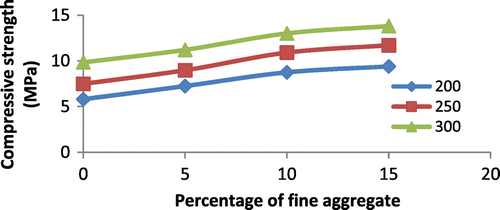
Figure 6. Compressive strength of pervious fly ash–cement for various binder contents and percentage of fines (10% fly ash replacement).
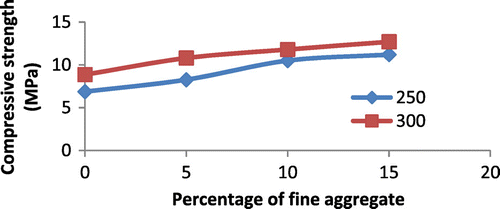
Figure 7. Compressive strength of pervious fly ash–cement for various binder contents and percentage of fines (20% fly ash replacement).
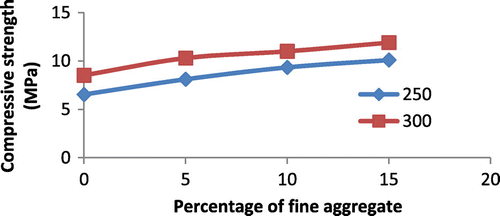
The compressive strength range achieved by pervious cement concrete and fly ash–cement concretes fulfils the requirement for use as LCC in flexible pavement, as per the relevant Indian codes (Table ) except, the pervious cement concrete and fly ash cement concrete with cement content 250 kg/m3 (no fine and 5% fines). In other words, pervious cement and fly ash cement concretes with cement content 250 kg/m3, having 10 and 15% fines content and with 10 and 20% replacement of cement by fly ash, satisfy the requirements of DLC.
Table 5. Strength requirements for LCC and DLC as per Indian Standards
However, for the cement content of 300 kg/m3, for all fines content and fly ash replacement levels, the compressive strength attained satisfy the requirements of DLC. Hence, the compressive strength ranges of the mixes with cement content 250 kg/m3 reported in this study are compared with that of the strength range of the mixes with the same cement content, but without using plasticizer, and reported by the authors elsewhere (Uma Maguesvari & Sundararajan, Citationin press). The above comparison is given in Table . It is seen that the influence of the plasticizer is to impart “marginal” to “slight” improvement in the compressive strength of pervious concretes, even for the cement content 250 kg/m3. On the other hand, the minimum cement/binder content for all pervious concretes, without the use of plasticizer, to be used in DLC of a rigid pavement is 300 kg/m3. Thus, there is substantial savings in the use of cement for pervious concrete, if plasticizer is used.
Table 6. Comparison of the compressive strength of pervious concretes with and without plasticizer, for the cement content of 250 kg/m3
It is observed that the 7-days compressive strength behaviour of all pervious concretes considered in the study are similar to that of 28-days compressive strength (Figure ).
3.3. Flexural and split tensile strength
Variation of flexural and split tensile strengths of pervious concrete for various cement contents, percentage of fines, and for two levels of replacement of cement by fly ash, are shown in Figures and , respectively. Both the above strength behaviour is similar to that of the corresponding compressive strength behaviour with respect to no fines, range of fines and replacement levels of cement by fly ash, considered. The flexural strength attained is in the range of 1.44–1.88 MPa and 1.47–1.70 MPa, for no fines pervious cement concrete and fly ash–cement concrete, respectively. The flexural strength of pervious cement concretes and fly ash–cement concretes are in the range of 1.76–2.68 MPa, for all the ranges of fines considered (Figure ). Similarly, split tensile strength attained is in the range of 1.53–2.06 MPa and 1.63–2.15 MPa for no fines pervious cement concretes and fly ash–cement concretes (Figure ). The split tensile strength of pervious cement concrete and fly ash–cement concrete ranges from 1.59 to 2.65 MPa, for all ranges of fines considered. It is observed that replacement of cement by fly ash, up to 20%, has reduced marginally the flexural and split tensile strengths of pervious fly ash–cement concretes.
3.4. Total voids
The total voids content is in the range of 18.68–28.70% for pervious cement concrete, with and without fines. Addition of fines in pervious cement concrete reduces the total voids. In the case of pervious fly ash–cement concrete, with and without fines, the total voids content is in the range of 18.19–26.47% (for 10% replacement of cement by fly ash) and 16.82–23.55% (for 20% replacement of cement by fly ash) (Figure ). It can be seen that replacement of cement by fly ash has resulted in the reduction of total voids, and this may be attributed to the micro-filler effect of fly ash and that of plasticizer, which has caused a cohesive action, thereby reducing the total voids in the above pervious concrete.
3.5. Permeability
Permeability of pervious cement concretes, without fines, decrease with increase in cement content, and it ranges from 1.650 to 0.889 cm/s. The same trend is exhibited by pervious fly ash–cement concretes for all replacement levels of cement by fly ash and fine aggregates content considered, and it ranges from 1.093 to 0.354 cm/s. The average reduction in permeability of pervious fly ash–cement concrete is about 13.28%, considering the effect of fines and no fines (Figure ). Permeability of pervious cement concrete and fly ash–cement concrete (for 20% replacement of cement by fly ash) using plasticizer with fines, and for the binder content 250 kg/m3 are: 1.149 to 0.675 cm/s and 0.993 to 0.469 cm/s, respectively. However, for the corresponding mixes, without the use of plasticizer, it ranges between 1.248 and 0.973 cm/s and 1.068 and 0.615 cm/s, respectively. It can be seen that the use of plasticizer has caused a reduction in permeability of about 31.71% in pervious cement concrete, and 25.14% in pervious fly ash–cement pervious concrete.
3.6. Influence of total voids on compressive strength
The total voids content is in the range of 18.68–28.70%, for pervious cement concrete, with and without fines. The corresponding compressive strength of the above pervious concrete ranges from 5.8 to 13.80 MPa (Figure ). In the case of pervious fly ash–cement concrete, with and without fines, the total void content is in the range of 18.19–26.47% (for 10% replacement of cement by fly ash) and 16.82–23.55% (for 20% replacement of cement by fly ash). The corresponding compressive strength of the above pervious concrete ranges from 6.87 to 12.70 MPa (10% replacement of cement by fly ash) and 6.54 to 11.90 MPa (20% replacement of cement by fly ash) (Figures and ). The above total voids content and the compressive strength ranges are within the typical void content and strength ranges of pervious concrete as reported in ACI 522 R-10. In general, replacement of cement by fly ash has resulted in reduction in total voids content, and this is primarily attributed to the micro-filler effect of fly ash, and addition of plasticizer which caused a cohesive action, thereby reducing the total voids in the pervious concrete. In spite of the above effect, addition of fly ash still retains the beneficial effects from technical, economic and environmental considerations. The trends in variation of compressive strength with total voids are similar both for pervious cement concrete and pervious fly ash–cement concrete (Figures –).
3.7. Influence of permeable voids on permeability
Increase in permeable voids increases the permeability and it is dependent of the binder content (cement/fly ash) in pervious concretes (Figures –). Permeable voids in pervious cement concretes vary from 17.85 to 27.23% and its corresponding permeability is 0.488–1.650 cm/s. In the case of pervious fly ash–cement concrete, with and without fines, permeable voids are in the range of 16.42–24.79%, for 10% replacement of cement by fly ash and its corresponding permeability is 0.456–1.09 cm/s. It is 15.01–20.67%, for 20% replacement of cement by fly ash and its corresponding permeability is 0.354–0.993 cm/s.
3.8. Influence of total voids on abrasion
The weight-loss in percentage (sand blasting) ranges from 0.035 to 0.191%, whereas, Cantabro loss is in the range from 35.02 to 95.71% for pervious cement concrete, with and without fines (Figures and ). The above abrasion loss corresponds to the total voids content range of 18.68–28.70% in the above concrete. In the case of pervious fly ash–cement concrete, with and without fines, the total void contents are in the range of 18.18–26.47%. For 10% replacement of cement by fly ash in the above concrete, the percentage weight loss (sand blasting) is 0.046–0.159%, whereas, cantabro loss is 38.76–86.59% (Figures and ). When the replacement of cement by fly ash is 20% in the above concrete, the total void content is in the range of 16.82–23.55%, and the corresponding percentage of weight loss (sand blasting) is 0.061–0.164% and the cantabro loss is 42.20–98.50% (Figures and ). From Figures –, it can be seen that the trend in the increase of total voids results in the increase of the percentage of weight loss (sand blasting and cantabro loss), for both pervious cement and fly ash–cement concretes, and with/without fines.
Figure 21. Effect of total void on the weight loss (sand blasting) of fly ash–cement concretes (10% fly ash replacement).
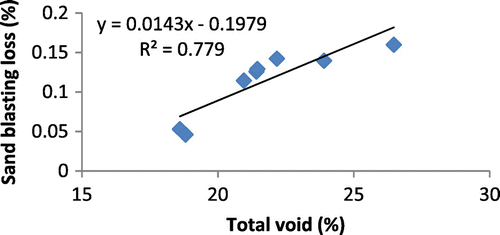
Figure 22. Effect of total void on the weight loss (sand blasting) of fly ash–cement concretes (20% fly ash replacement).

Figure 23. Effect of total void on the cantabro loss of fly ash–cement concretes (10% fly ash replacement).
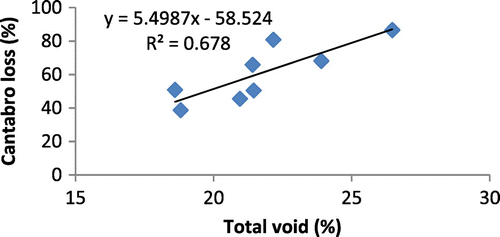
Figure 24. Effect of total void on the cantabro loss of fly ash–cement concretes (20% fly ash replacement).
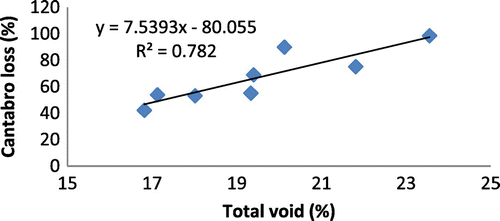
According to IS:9284-1979 the maximum abrasion loss (sand blasting) is 0.16% for concrete pavements. It can be seen that the abrasion loss obtained for pervious cement concrete and pervious fly ash–cement concrete, are within the limit specified in the above IS code. According to ASTM C1747/C1747M-13 (Citation2013) for the designed void contents of 18, 20 and 22%, the corresponding percent weight loss ranges between 19 and 95%. Cantabro loss evaluated in this study varies from 35.01 to 98.05% and its corresponding total voids is 18.68–23.55%, considering both pervious cement and fly ash cement concretes, with and without fines. The above range of cantabro loss obtained in this study is closer to the weight loss reported for pervious concretes in ASTM C1747/C1747M-13 (Citation2013).
4. Conclusions
The actual compressive strength of pervious cement concrete (at 28 days), with and without fines, ranges from 5.8 to 13.80 MPa for cement contents ranging from 200 to 300 kg/m3, and using a commercial plasticizer (0.8%—by weight of binder). The above strength range achieved in this study has the potential for use as a typical sub-base/base layer in a flexible pavement, and as a sub-base in a rigid pavement (as per Indian codes). 10 and 20% replacement of cement by fly ash (on weight basis) has reduced the above compressive strength range only marginally, and therefore, it still has potential applications in flexible and rigid pavements, after improving the strength by various established methods. Addition of fine aggregates (ranging from 5 to 15%) has increased the compressive strength from “marginal” to “high” for both cement and fly ash–cement based pervious concretes, when compared to “no fines” pervious concretes. Strength behaviour of flexural and split tensile strength is similar to that of the corresponding compressive strength behaviour of pervious concrete, for all the parameters and their ranges, considered in this study. The total voids content of pervious cement concrete, with and without fines, is within the typical void content reported in ACI 522 R-10. However, replacement of cement by fly ash in pervious concrete has resulted in the reduction of total voids, which may be attributed to the micro-filler effect of fly ash. Consequently, there is a reduction of about 13.28% in permeability of pervious fly ash–cement concretes, considering all the effect of no fines and fines in the above two systems. The total void content increases the percentage of loss (sand blasting and Cantabro loss) in both the pervious cement concrete and pervious cement–fly ash concretes, considering with and without fines. There is substantial savings in the binder content due to the use of plasticizer. There is reduction in the permeability, total and permeable voids content, of pervious concretes, with/without fines due to the use of plasticizer. All the mixes considered in this study with a minimum cement content 250 kg/m3 and with 10 and 20% of replacement of the above cement content by fly ash, and with fines content 10 and 15%, can be considered for the application of DLC as a base coarse for rigid/ flexible pavements, according to IS codes.
Supplementary material
Supplementary material for this article can be accessed here http://dx.doi.org/10.1080/23311916.2017.1318802.
OAEN_1318802_Supplementary_Material.docx
Download MS Word (13.2 KB)Acknowledgement
The authors would like to acknowledge the support and cooperation extended by the Department of Civil Engineering, Pondicherry Engineering College, Pondicherry, India, to carry out this work.
Additional information
Funding
Notes on contributors
Uma Maguesvari Muthaiyan
Uma Maguesvari Muthaiyan is a research scholar in the Department of Civil Engineering, Pondicherry Engineering College, Pondicherry, India. Her research interest is in pervious concrete and its characterization. She has teaching experience in the similar field for more than 10 years.
Sundararajan Thirumalai
Dr Sundararajan Thirumalai is currently professor of Civil Engineering at Pondicherry Engineering College, Pondicherry, India. He has a total of over 38 years of experience covering all facets of Civil engineering. He earned his PhD from Indian Institute of Technology, Madras. His areas of research interests include: water resources engineering, computer applications in civil engineering, construction management. He has made extensive/overseen studies in the areas of natural fibre cementitious composites, fly ash activation and applications, and in general, in the area of supplementary cementitious materials and applications.
References
- ACI 522R-10. (2010). Report on pervious concrete.
- Aoki, Y., Ravindrarajah, R. S., & Khabbaz, H. (2012). Properties of pervious concrete containing fly ash. Road Materials and Pavement Design, 13, 1–11.10.1080/14680629.2011.651834
- ASTM C1754/C1754M-12. (2012). Standard test method for density and void content of hardened pervious concrete.
- ASTM C1747/C1747M-13. (2013). Standard test method for determining potential resistance to degradation of pervious concrete by impact and abrasion.
- Chen, Y., Wang, K., Wang, X., & Zhou, W. (2013). Strength, fracture and fatigue of pervious concrete. Construction and Building Materials, 42, 97–104.10.1016/j.conbuildmat.2013.01.006
- Cheng, A., Hsu, H. M., Chao, S. J., & Lin, K. L. (2011). Experimental study on properties of pervious concrete made with recycled aggregate. Internal Journal of Pavement Research and Technology, 4, 104–110.
- Deo, O., & Neithalath, N. (2010). Compressive behavior of pervious concretes and a quantification of the influence of random pore structure features. Materials Science and Engineering: A, 528, 402–412.10.1016/j.msea.2010.09.024
- Dong, Q., Wu, H., Huang, B., Shu, X., & Wang, K. (2013). Investigation into laboratory abrasion test methods for pervious concrete. Journal of Materials in Civil Engineering, 25, 886–892.10.1061/(ASCE)MT.1943-5533.0000683
- Gesoğlu, M., Güneyisi, E., Khoshnaw, G., & İpek, S. (2014). Investigating properties of pervious concretes containing waste tire rubbers. Construction and Building Materials, 63, 206–213.10.1016/j.conbuildmat.2014.04.046
- Girish, G., & Manjunath Rao, R. (2011). A step towards mix proportioning guidelines for pervious concrete. International Journal of Earth Sciences and Engineering, 4, 768–771.
- Güneyisi, E., Gesoğlu, M., Kareem, Q., & İpek, S. (2016). Effect of different substitution of natural aggregate by recycled aggregate on performance characteristics of pervious concrete. Materials and Structures, 49, 521–536. doi:10.1617/s11527-014-0517-y
- Hager, A., Durham, S. A., & Rens, K. (2016). Sustainable design of pervious concrete pavement systems. Submitted to the Transportation Research Board (TRB) for Presentation at the TRB and Publication in the Transportation Research Record, Washington, DC.
- Hesami, S., Ahmadi, S., & Nematzadeh, M. (2014). Effects of rice husk ash and fiber on mechanical properties of pervious concrete pavement. Construction and Building Materials, 53, 680–691.10.1016/j.conbuildmat.2013.11.070
- Hossain, T., Salam, M. A., & Kader, M. A. (2012). Pervious concrete using brick chips as coarse aggregate: An experimental study. Journal of Civil Engineering (IEB), 40, 125–137.
- Huang, B., Wu, H., Shu, X., & Burdette, E. G. (2010). Laboratory evaluation of permeability and strength of polymer-modified pervious concrete. Construction and Building Materials, 24, 818–823.10.1016/j.conbuildmat.2009.10.025
- IRC58-2015. (2015). Guidelines for the design of plain jointed rigid pavements for highways - 4th Revision..
- IRC74-1979. (1979). Tentative guidelines for lean-cement concrete and lean cement fly ash concrete as a pavement base or sub base.
- IRCSP49-2014. (2014). Guidelines for the use of dry lean concrete as sub-base for rigid pavement - 1st Revision 2014.
- IS 4031: Part 3. (1988). Methods of physical tests for hydraulic cement: Part 3 Determination of soundness.
- IS 4031: Part 4. (1988). Methods of physical tests for hydraulic cement: Part 4 Determination of consistency of standard cement paste.
- IS 4031: Part 5. (1988). Methods of physical tests for hydraulic cement: Part 5 Determination of initial and final setting times.
- Kevern, J. T., Wang, K., & Schaefer, V. R. (2009). The effect of curing regime on pervious concrete abrasion resistance. Journal of Testing and Evaluation, 37, 337–342.
- Kuo, W. T., Liu, C. C., & Su, D. S. (2013). Use of washed municipal solid waste incinerator bottom ash in pervious concrete. Cement and Concrete Composites, 37, 328–335.10.1016/j.cemconcomp.2013.01.001
- Lian, C., & Zhuge, Y. (2010). Optimum mix design of enhanced permeable concrete – An experimental investigation. Construction and Building Materials, 24, 2664–2671.10.1016/j.conbuildmat.2010.04.057
- McCain, G. N., & Dewoolkar, M. M. (2009). Strength and permeability characteristics of porous concrete pavements. Transportation Research Board, 1–13.
- Neithalath, N., Sumanasooriya, M. S., & Deo, O. (2010). Characterizing pore volume, sizes, and connectivity in pervious concretes for permeability prediction. Materials Characterization, 61, 802–813.
- Neithalath, N., Weiss, J., & Olek, J. (2006). Characterizing enhanced porosity concrete using electrical impedance to predict acoustic and hydraulic performance. Cement and Concrete Research, 36, 2074–2085.10.1016/j.cemconres.2006.09.001
- Neville, A. M. (2006). Size effects in compressive strength. In A. M. Neville (Ed.), Properties of concrete (pp. 605–607). South Asia: Pearson Education.
- Nguyen, D. H., Boutouil, M., Sebaibi, N., Leleyter, L., & Baraud, F. (2013). Valorization of seashell by - products in pervious concrete pavers. Construction and Building Materials, 49, 151–160.10.1016/j.conbuildmat.2013.08.017
- Nguyen, D. H., Sebaibi, N., Boutouil, M., Leleyter, L., & Baraud, F. (2014). A modified method for the design of pervious concrete mix. Construction and Building Materials, 73, 271–282.10.1016/j.conbuildmat.2014.09.088
- Rafique, A. M., Bhutta, M., Tsuruta, K., & Mirza, J. (2012). Evaluation of high-performance porous concrete properties. Construction and Building Materials, 31, 67–73.
- Rafique, A. M., Bhutta, M., Tsuruta, K., & Mirza, J. (2013). Properties of porous concrete from waste crushed concrete (recycled aggregate). Construction and building materials, 47, 1243–1248.
- Ravi Shankar, A. U., & Palankar, N. (2015). A study on porous concrete mixes for rigid pavements. Indian Highways, 43, 37–41.
- Sata, V., Wongsa, A., & Chindaprasirt, P. (2013). Properties of pervious geopolymer concrete using recycled aggregates. Construction and Building Materials, 42, 33–39.10.1016/j.conbuildmat.2012.12.046
- Seo, D. S. (2006). An experimental study on sound absorption properties of multi-functional porous concrete for building material (PhD Thesis). Chungnam National University, Daejeon.
- Uma Maguesvari, M., & Sundararajan, T. (in press). Influence of fly ash and fine aggregates on the characteristics of pervious concrete. International Journal of Applied Engineering Research.
- Wu, H., Huang, B., Shu, X., & Dong, Q. (2011). Laboratory evaluation of abrasion resistance of portland cement pervious concrete. Journal of Materials in Civil Engineering., 23, 697–702.10.1061/(ASCE)MT.1943-5533.0000210

